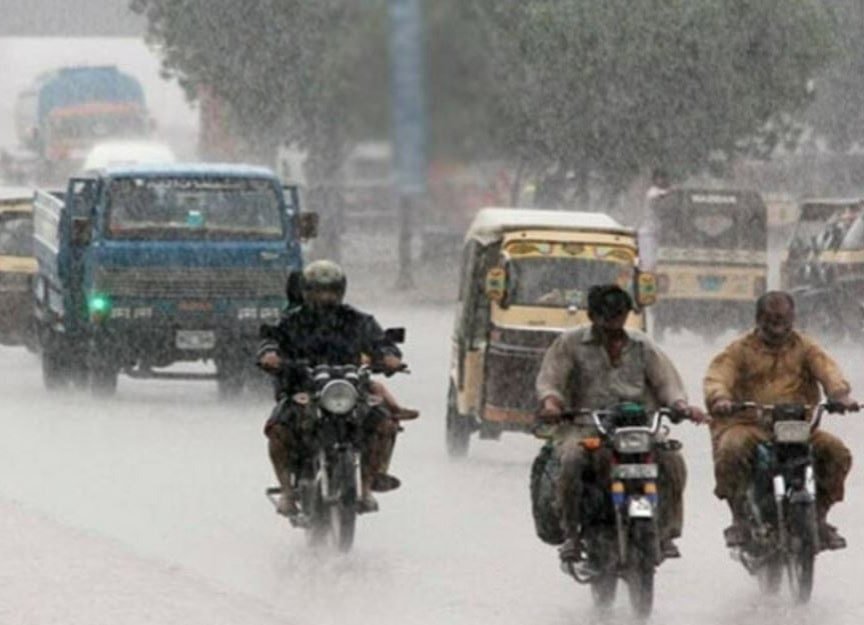Monsoon Returns: Karachi and Hyderabad Brace for New Rain Spell Amid Power Outages and Flood Warnings
By TN Web Desk | June 27, 2025
As the monsoon season begins to take hold, Karachi and Hyderabad have been hit with the first wave of rains, offering some relief from the sweltering summer heat but also ushering in a fresh set of challenges. The Pakistan Meteorological Department (PMD) has forecast another spell of rainfall for Karachi and Hyderabad beginning today, June 27, and continuing through June 29. Alongside showers, strong winds and dust storms are expected across several parts of the country, particularly in the southern and western regions of Pakistan.
This latest weather development comes after both cities witnessed their first significant monsoon rainfall overnight on June 26, bringing not just thunder and lightning but also a taste of seasonal chaos. While residents welcomed the break from the blistering temperatures, the rainfall also revealed the fragility of urban infrastructure, leading to power outages, traffic congestion, and tragic accidents.
First Monsoon Spell Hits Karachi and Hyderabad
Residents of Karachi woke up to cloudy skies and cooler winds after heavy rain lashed the city overnight. Thunderstorms accompanied by lightning brought temporary relief from the relentless summer heat, pushing temperatures down from over 40°C to the high 20s. The sudden downpour, however, also exposed the city’s vulnerability to rain-induced disruptions.
In Hyderabad, the rainfall was equally intense. Streets were flooded, and in a tragic incident, the roof of a madrassa collapsed due to the downpour. Two children lost their lives in the incident, while 14 others sustained injuries. The collapse is a stark reminder of the poor structural conditions in many educational and residential buildings across the region.
Karachi’s Drainage System Overwhelmed Once Again
Despite repeated assurances from the authorities about being better prepared for this year’s monsoon season, Karachi’s drainage system once again failed to withstand the heavy rain. Several low-lying areas, including parts of Saddar, Liaquatabad, Korangi, and Orangi Town, were submerged in rainwater. Local residents reported that the water remained uncleared for hours, further complicating traffic movement and increasing the risk of waterborne diseases.
According to city officials, over 350 electricity feeders tripped during the rainstorm, resulting in large-scale power outages that affected neighborhoods across the city, including Gulshan-e-Iqbal, Federal B Area, and Malir. Power utility company K-Electric stated that their teams were working round-the-clock to restore supply but noted that safety concerns were delaying full restoration in flooded zones.
Karachi Mayor Visits Affected Areas
In response to the deteriorating conditions, Karachi Mayor Murtaza Wahab conducted inspections across several neighborhoods hit hard by the rain. He visited Defence, Clifton, the South District, Governor House, the Sindh Assembly, and the Supreme Court building to assess the situation. The mayor was accompanied by the municipal commissioner and other city officials who briefed him on the drainage operations and the status of stormwater drains.
Mayor Wahab instructed all municipal workers to remain on high alert and canceled all official leaves to ensure the availability of emergency response teams throughout the city. He also directed authorities to speed up cleaning operations in nullahs and sewage lines to prevent future blockages during the ongoing monsoon spell.
PMD Forecast: Rain to Continue Until June 29
The Pakistan Meteorological Department issued a warning that the ongoing weather system is likely to bring further rain across southern Sindh, including Karachi, Hyderabad, Thatta, Badin, Mirpurkhas, and Nawabshah. A westerly weather system has moved in over the western parts of the country, pushing moisture-laden clouds towards the southern belt.
According to the forecast, thunderstorms, gusty winds, and scattered rain showers are expected through June 29. The PMD has also warned of potential flash floods in seasonal nullahs and urban flooding in densely populated cities where drainage infrastructure remains under strain.
The department advised local administrations to stay alert and take necessary precautions, especially in flood-prone areas.
Impact on Daily Life and Public Services
With major roads and intersections waterlogged, daily life came to a grinding halt in many parts of Karachi and Hyderabad. Commuters faced long delays, and several public transportation routes were suspended or redirected due to impassable streets. Rickshaws and motorbikes, common means of transport in urban Sindh, were seen struggling through deep puddles and broken roads.
In residential neighborhoods, standing water seeped into homes and ground floors, damaging furniture and electrical appliances. Residents also reported an increase in mosquitoes and other insects within hours of the rainfall.
Educational institutions and offices in several rain-hit zones operated on reduced hours or remained closed, while many businesses faced internet and power outages disrupting regular operations.
Disaster Preparedness in Question
The situation has reignited debates about Karachi and Hyderabad’s preparedness for monsoon rains. Despite years of experience dealing with seasonal flooding, authorities continue to face criticism for what residents call “last-minute reactions” rather than preventive planning.
Urban planning experts argue that inadequate investment in drainage and waste management systems, coupled with rampant encroachments on stormwater drains, has made both cities increasingly vulnerable to even moderate rain spells.
In a recent press conference, urban development analysts called for urgent long-term planning, including:
-
Regular cleaning of nullahs before monsoon season begins
-
Investment in new drainage systems
-
Banning construction over natural waterways
-
Educating the public on waste disposal to prevent drain blockages
Hyderabad’s Tragedy Sparks Concern
The madrassa roof collapse in Hyderabad is being treated as a major incident and has drawn condemnation from political leaders and civil society. Eyewitnesses reported that the roof had visible cracks but no repairs were made despite warnings from parents and residents.
Local authorities have ordered an investigation into the incident, and Chief Minister of Sindh has promised compensation for the victims’ families. However, residents argue that such promises are often made but rarely fulfilled.
The tragedy also highlights the broader issue of unsafe infrastructure in both rural and urban Sindh, where schools, hospitals, and mosques are often constructed with substandard materials and poor engineering.
Relief Efforts and Public Response
While the rain provided some visual relief with cooler weather and greener surroundings, the human cost and infrastructural damage quickly shifted public mood from joy to frustration.
Social media was flooded with pictures and videos of flooded streets, fallen trees, submerged vehicles, and frustrated commuters. The hashtags #KarachiRain, #HyderabadFlood, and #Monsoon2025 trended for hours as citizens vented their anger over recurring civic failures.
Volunteer groups and NGOs mobilized quickly, offering shelter, food, and first-aid kits in severely affected neighborhoods. Many young volunteers were seen clearing drains, redirecting traffic, and helping elderly citizens navigate waterlogged roads.
Looking Ahead: More Rain Expected
The weather forecast suggests more rain is on the horizon. With the monsoon season just beginning, authorities must prepare for more intense spells over the coming weeks. The PMD’s long-range forecast indicates that July may see above-normal rainfall in southern Pakistan, which could intensify the current crisis if immediate steps are not taken.
The National Disaster Management Authority (NDMA) has advised all provincial disaster units to remain vigilant and ensure timely distribution of relief supplies in affected areas. Rescue teams are also being put on standby in regions identified as high-risk for flooding and landslides
What Citizens Can Do
Amid warnings of more rain, citizens are being urged to take basic safety precautions to protect themselves and their families. These include:
-
Avoid traveling during peak rainfall hours
-
Stay indoors during thunderstorms
-
Refrain from touching exposed electric poles and wires
-
Use waterproof bags to protect important documents and devices
-
Clear garbage from street drains near homes
-
Keep emergency kits and essential medicines ready
Conclusion
As Karachi and Hyderabad navigate the initial wave of monsoon showers, the duality of nature’s blessing and infrastructure’s curse becomes evident once again. The rains offer relief from heat but highlight how far the country’s major cities still have to go in terms of preparedness and response. With more showers on the way and already mounting damage, the time for temporary fixes is over. Long-term, sustainable solutions must now become a priority if urban Sindh is to safely weather the rest of the monsoon season.
Demi Lovato draws flak for basic avocado toast tutorial 7
Read This Artical
Monsoon Returns: Karachi and Hyderabad Brace for New Rain Spell Amid Power Outages and Flood Warnings
By TN Web Desk | June 27, 2025
As the monsoon season begins to take hold, Karachi and Hyderabad have been hit with the first wave of rains, offering some relief from the sweltering summer heat but also ushering in a fresh set of challenges. The Pakistan Meteorological Department (PMD) has forecast another spell of rainfall for Karachi and Hyderabad beginning today, June 27, and continuing through June 29. Alongside showers, strong winds and dust storms are expected across several parts of the country, particularly in the southern and western regions of Pakistan.
This latest weather development comes after both cities witnessed their first significant monsoon rainfall overnight on June 26, bringing not just thunder and lightning but also a taste of seasonal chaos. While residents welcomed the break from the blistering temperatures, the rainfall also revealed the fragility of urban infrastructure, leading to power outages, traffic congestion, and tragic accidents.
First Monsoon Spell Hits Karachi and Hyderabad
Residents of Karachi woke up to cloudy skies and cooler winds after heavy rain lashed the city overnight. Thunderstorms accompanied by lightning brought temporary relief from the relentless summer heat, pushing temperatures down from over 40°C to the high 20s. The sudden downpour, however, also exposed the city’s vulnerability to rain-induced disruptions.
In Hyderabad, the rainfall was equally intense. Streets were flooded, and in a tragic incident, the roof of a madrassa collapsed due to the downpour. Two children lost their lives in the incident, while 14 others sustained injuries. The collapse is a stark reminder of the poor structural conditions in many educational and residential buildings across the region.
Karachi’s Drainage System Overwhelmed Once Again
Despite repeated assurances from the authorities about being better prepared for this year’s monsoon season, Karachi’s drainage system once again failed to withstand the heavy rain. Several low-lying areas, including parts of Saddar, Liaquatabad, Korangi, and Orangi Town, were submerged in rainwater. Local residents reported that the water remained uncleared for hours, further complicating traffic movement and increasing the risk of waterborne diseases.
According to city officials, over 350 electricity feeders tripped during the rainstorm, resulting in large-scale power outages that affected neighborhoods across the city, including Gulshan-e-Iqbal, Federal B Area, and Malir. Power utility company K-Electric stated that their teams were working round-the-clock to restore supply but noted that safety concerns were delaying full restoration in flooded zones.
Karachi Mayor Visits Affected Areas
In response to the deteriorating conditions, Karachi Mayor Murtaza Wahab conducted inspections across several neighborhoods hit hard by the rain. He visited Defence, Clifton, the South District, Governor House, the Sindh Assembly, and the Supreme Court building to assess the situation. The mayor was accompanied by the municipal commissioner and other city officials who briefed him on the drainage operations and the status of stormwater drains.
Mayor Wahab instructed all municipal workers to remain on high alert and canceled all official leaves to ensure the availability of emergency response teams throughout the city. He also directed authorities to speed up cleaning operations in nullahs and sewage lines to prevent future blockages during the ongoing monsoon spell.
PMD Forecast: Rain to Continue Until June 29
The Pakistan Meteorological Department issued a warning that the ongoing weather system is likely to bring further rain across southern Sindh, including Karachi, Hyderabad, Thatta, Badin, Mirpurkhas, and Nawabshah. A westerly weather system has moved in over the western parts of the country, pushing moisture-laden clouds towards the southern belt.
According to the forecast, thunderstorms, gusty winds, and scattered rain showers are expected through June 29. The PMD has also warned of potential flash floods in seasonal nullahs and urban flooding in densely populated cities where drainage infrastructure remains under strain. forecast.
The department advised local administrations to stay alert and take necessary precautions, especially in flood-prone areas. forecast.
Impact on Daily Life and Public Services
With major roads and intersections waterlogged, daily life came to a grinding halt in many parts of Karachi and Hyderabad. Commuters faced long delays, and several public transportation routes were suspended or redirected due to impassable streets. Rickshaws and motorbikes, common means of transport in urban Sindh, were seen struggling through deep puddles and broken roads. forecast.
In residential neighborhoods, standing water seeped into homes and ground floors, damaging furniture and electrical appliances. Residents also reported an increase in mosquitoes and other insects within hours of the rainfall.
Educational institutions and offices in several rain-hit zones operated on reduced hours or remained closed, while many businesses faced internet and power outages disrupting regular operations. forecast
Disaster Preparedness in Question
The situation has reignited debates about Karachi and Hyderabad’s preparedness for monsoon rains. Despite years of experience dealing with seasonal flooding, authorities continue to face criticism for what residents call “last-minute reactions” rather than preventive planning. forecast.
Urban planning experts argue that inadequate investment in drainage and waste management systems, coupled with rampant encroachments on stormwater drains, has made both cities increasingly vulnerable to even moderate rain spells.
In a recent press conference, urban development analysts called for urgent long-term planning, including: forecast.
-
Regular cleaning of nullahs before monsoon season begins forecast.
-
Investment in new drainage systems forecast.
-
Banning construction over natural waterways forecast.
-
Educating the public on waste disposal to prevent drain blockages forecast.
Hyderabad’s Tragedy Sparks Concern
The madrassa roof collapse in Hyderabad is being treated as a major incident and has drawn condemnation from political leaders and civil society. Eyewitnesses reported that the roof had visible cracks but no repairs were made despite warnings from parents and residents. forecast.
Local authorities have ordered an investigation into the incident, and Chief Minister of Sindh has promised compensation for the victims’ families. However, residents argue that such promises are often made but rarely fulfilled. forecast.
The tragedy also highlights the broader issue of unsafe infrastructure in both rural and urban Sindh, where schools, hospitals, and mosques are often constructed with substandard materials and poor engineering.While the rain provided some visual relief with cooler weather and greener surroundings, the human cost and infrastructural damage quickly shifted public mood from joy to frustration.vvv forecast.
Social media was flooded with pictures and videos of flooded streets, fallen trees, submerged vehicles, and frustrated commuters. The hashtags #KarachiRain, #HyderabadFlood, and #Monsoon2025 trended for hours as citizens vented their anger over recurring forecast.
Volunteer groups and NGOs mobilized quickly, offering shelter, food, and first-aid kits in severely affected neighborhoods. Many young volunteers were seen clearing drains, redirecting traffic, and helping elderly citizens navigate waterlogged roads.Looking Ahead: More Rain Expected forecast.
The weather forecast suggests more rain is on the horizon. With the monsoon season just beginning, authorities must prepare for more intense spells over the coming weeks. The PMD’s long-range forecast indicates that July may see above-normal rainfall in southern Pakistan, which could intensify the current crisis if immediate steps are not taken.
The National Disaster Management Authority (NDMA) has advised all provincial disaster units to remain vigilant and ensure timely distribution of relief supplies in affected areas. Rescue teams are also being put on standby in regions identified as high-risk for flooding and landslides forecast forecast.
What Citizens Can Do
Amid warnings of more rain, citizens are being urged to take basic safety precautions to protect themselves and their families. These include:
-
Avoid traveling during peak rainfall hoursc forecast.
-
Stay indoors during thunderstorms forecast.
-
Refrain from touching exposed electric poles and wires forecast.
-
Use waterproof bags to protect important documents and devices forecast
-
Clear garbage from street drains near homes forecast,
-
Keep emergency kits and essential medicines ready forecast.
Conclusion
As Karachi and Hyderabad navigate the initial wave of monsoon showers, the duality of nature’s blessing and infrastructure’s curse becomes evident once again. The rains offer relief from heat but highlight how far the country’s major cities still have to go in terms of preparedness and response. With more showers on the way and already mounting damage, the time for temporary fixes is over. Long-term, sustainable solutions must now become a priority if urban Sindh is to safely weather the rest of the monsoon season.




